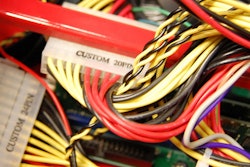In the past few years, major manufacturers have been quick to introduce robotics into their manufacturing operations—so much so that there’s talk of a “robotics revolution.” In fact, according to Recode, approximately 1.2 million industrial robots are expected to be in operation throughout the industrial world by 2025.
This trend isn’t surprising—robots can help deliver significant productivity and efficiency improvements to all kinds of manufacturing operations. And, when integrated strategically in an operation, they can actually enhance the productivity of human employees, freeing them up from repetitive or dangerous tasks to do more productive work.
However, robots only provide an advantage to manufacturers if they operate reliably. Like any industrial machine, even a minor breakdown can result in missed production goals.
And, as the conversation around robotics continues to grow, there’s an important need to discuss the role that lubrication—and specifically grease—plays in enabling the robotics revolution. It’s paramount that plant owners implement the right maintenance practices to support advanced robotics equipment, starting with an advanced lubrication program.
It All Starts With the Right Grease
Some of the most important components that influence the reliability of robotic equipment are bearings and reducer gear drives, which are lubricated with grease.
Grease is critical in helping withstand damaging conditions like wear (from metal-to-metal contact), rust/corrosion (from regular exposure to corrosive fluids like water), and contamination. In the context of industrial robots, grease plays a role in ensuring that robotic equipment continues to meet its impressive production time and quality expectations.
By better protecting bearings, operators can ultimately reduce unscheduled downtime, extend equipment life and extend maintenance service intervals.
So, what should operators look for when selecting a grease for these applications?
Well, there are a few simple parameters:
- Grease should be semi-fluid (NLGI Grade 0 to 00), helping control a robot’s articulations.
- Although viscosity range is dependent on the equipment’s design, operators should use mineral or semi-synthetic grease with base oil viscosity ranging from ISO 46 to ISO 150. Viscosity focuses on reducing friction and allows more precise control of a robot.
- Grease should be based on either lithium or polyurea thickener technology. Both lithium and polyurea grease have been proven to provide reliable equipment protection for robotic applications.
By selecting a grease with the right characteristics, operators can extend equipment life by defending against degradation, contamination and extreme wear.
Benefits of Selecting the Right Grease
To understand the benefits of selecting the right grease, consider this example from another application that operates under extreme conditions – cement production.
Holcim Inc., a Michigan-based cement producer, was operating machinery with high-speed blower fan bearings that worked at temperatures of up to 210 degrees Fahrenheit. At one point, the company was experiencing three bearing failures per year, resulting in unscheduled downtime and significant costs related to lost productivity. To improve equipment reliability, the company consulted its grease supplier, which recommended switching to a synthetic grease specifically designed for extreme temperatures.
Since converting the bearings to a more compatible grease, the company was able to completely eliminate lubrication-related bearing failure. This extension of equipment life and improved reliability allowed the company to save $105,000 every year*.
In addition to reducing downtime and prolonging equipment life, high-performance greases can also lengthen re-lubrication intervals and reduce a plant’s overall grease intake.
The rigid nature of grease prevents lubricant leakage, allowing it to last longer within machine components. This, in turn, reduces the time and resources necessary for constant re-application. It also limits human-equipment interaction, which enhances safety and helps streamline the maintenance process for field personnel.
Again, consider this second example from the cement industry.
A Colombian cement plant was struggling with bearings that required frequent re-greasing due to high operating temperatures. After consulting its lubricant supplier, the company switched to a higher performance synthetic grease designed to reduce bearing leakage.
After switching to the new product, the company was able to double its re-greasing intervals, and reduce overall grease consumption, which generated about $177,000 in productivity savings*. The extension in lubrication intervals also benefited maintenance personnel, who experienced less exposure to machinery.
As this article makes clear, owners and operators must prioritize a plant’s grease program in order to fully reap the benefits of a robotic application. By doing so, they can extend the life of machinery and ultimately protect the hefty investment they’ve made in the robotics revolution.
*Based on the experience of a single customer. Actual results can vary depending upon the type of equipment used and its maintenance, operating conditions and environment, and any prior lubricant used.
Dr. Gary Dudley is a global grease product technical advisor for ExxonMobil Research and Engineering























